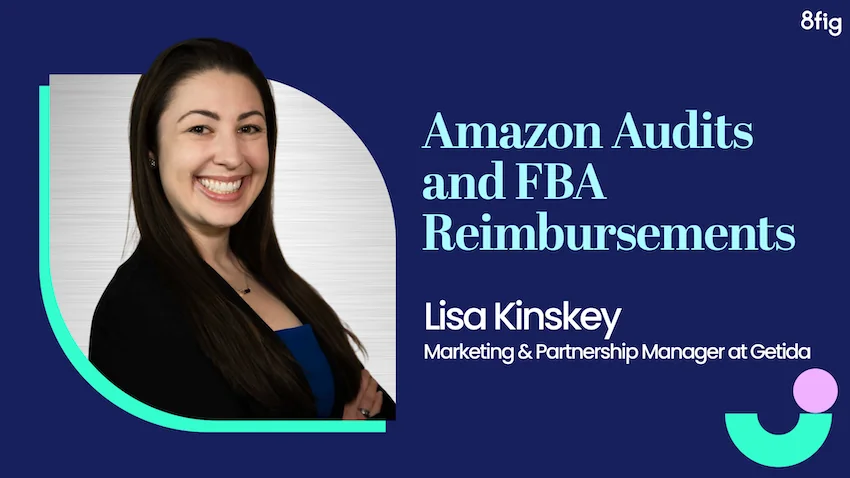An interview with Lisa Kinskey, Marketing & Partnership Manager at Getida.
My name is Lisa Kinskey. I am the marketing and partnerships manager at Getida. Prior to my time here, I joined in June of 2022, I actually worked in the supply chain industry. I joined in the middle of the pandemic, so that was an interesting time to join in July of 2020, but got to know the Getida team just through that experience and joined in June of last year.
And really my role is to assist with any of the marketing initiatives for our team, attend any of the conferences, you guys have probably seen me in at least a couple of shows. And also to build and strengthen the relationships with additional service providers in the industry that Gedita partners with.
Amazon auditing is kind of as it sounds. It’s auditing your Amazon account. So an audit is to do a deep dive, a comb through of everything, be sure that the T’s are crossed, I’s are dotted, and your information essentially as the seller, matches Amazon’s information.
So when Getida is conducting an audit, we’re looking for five different categories. Now, there’s nearly 30 different audit claim types that sellers could file for to get money back. But kind of the five main categories are going to be returns, audit, warehouse audit, accounting audit, available inventory level audit, and shipping audit.
So you can kind of see those as different facets of your business within FBA (Fulfilled by Amazon) where things could maybe go wrong that could cause sellers to have money back. So that’s really what we’re doing is we’re screening their Seller Central account to ensure that everything is accurate and up to date in FBA.
Sellers can determine if they are owed a reimbursement or refund by Amazon by auditing their account either in-house, or they’re welcome to use a service like Getida.
So when signing up for Getida, we do a direct connection via API into the Seller Central account. We just need the MWS (Amazon Marketplace Web Service) token and a few key details about the seller, name, email address, things like that. And we’ll conduct an 18-month look back. And on our dashboard you’ll actually see your initial potential recovery rate as we conduct that 18-month look back.
Subscribe to the eCommerce newsletter for
top industry insights
And then after we do the look back, we do a daily audit moving forward. And within our dashboard you’ll receive details regarding what kinds of audits are available to how much each audit is saying, okay, maybe you get at $1,000 on this shipment, $200 on this one. It breaks everything down for you really well. So using a service like Getida to give you an all encompassing look at what’s available for your account is one way.
But sellers are also more than welcome to go in through their various reports that you can run through Seller Central and compare the numbers, like the inbound shipping to say, okay, this shipment is in processing. If those numbers of “received” and “shipped” differ, that’s okay, because it’s still in processing. But if you shipped in an order of 100 units, you see that Amazon has received and closed that order, and they’re showing 90 units on their end, okay, we’ve got to take action here because there’s ten units that are missing.
So that’s what an internal audit can look like for a seller. It’s a little more time consuming, as you can imagine. But absolutely, they’re able to do this on their own.
Some of the reasons that FBA might owe a seller, you, a reimbursement or refund are going to be, the common ones that I list are lost, damaged, or wrongfully destroyed inventory.
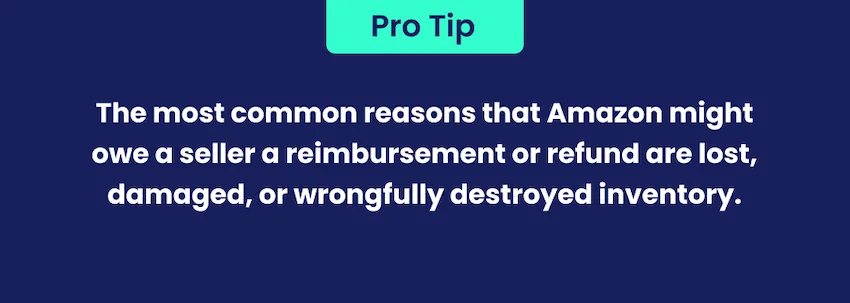
If there’s any weight and dimensions issues depending on how your item was scanned through their cubic scanning machine, it could be reading that it’s maybe two inches larger than it is putting you into the oversized category. So you would be owed reimbursement in that instance.
Again, there’s about 30 different FBA claim types. There’s some that involve customer returns, removal orders, missing inventory. I won’t go into them in depth, but there’s about 30 different reasons that a seller could be owed money by Amazon.
The way sellers get money back from Amazon when they’re owed is by filing a claim. Now different claim types have different time periods. This is why Getida goes back 18 months on the initial audit because some claim types have an 18 month window in which you can recoup those funds from Amazon. Some have nine, some have three, some have six. It just depends also on where you’re located, if your store’s in the UK or the US.
But the key is going to be to file the claim. And sellers are able to file these claims on their own. And what’s great about Amazon is it’s written into their terms of service that sellers are owed back the sell price.
So if you’ve run like a Lightning Deal or a promo code, there’s certain math that goes into this of what is the current retail price of your item or your listing price, if you will, but they’ll take like an average. But if you haven’t changed your price in the last, I think it’s 30 days, they will reimburse you the listing price, less FBA fees for that item.
So it’s as though you sold the products but you didn’t have to spend any PPC on it. So it’s a double win for the seller. So it’s already written into the terms of service that they’ll give you this money back. The key to it is just to find these discrepancies where they exist and to file the claim with Amazon.
They will reach out to you on certain occasions if they find something that has gone wrong and reimburse you automatically. But there are so many boxes flying through those warehouses every day. And there’s so many shipments coming in and out, things are bound to be missed. And that’s where services like Getida come in.
Again, sellers are more than welcome to file the claims on their own, and if they have a really small team, they may be able to manage it or maybe just a few orders. But once they begin to scale up, it becomes a little more difficult to manage. So that’s where Getida would come in.
The five categories of audits are going to be returns audit, warehouse audit, accounting audit, available inventory level audit, and shipping audit. And you can imagine how those would each fall into your seller account.
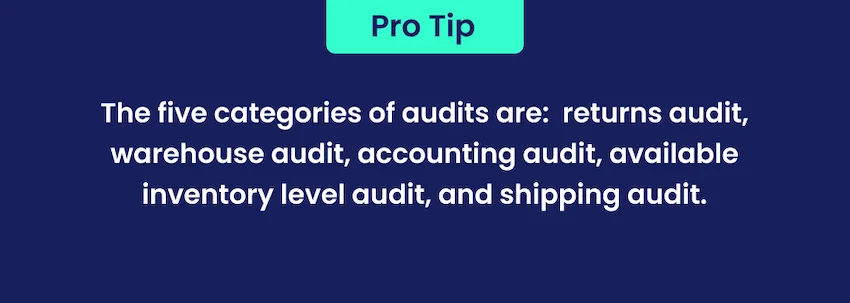
Your returns audit is going to be any issues with returns coming in from a customer that may be damaged, returns after 60 days, if they were granted a special return after the usual policy window, any return overcharges when an item was returned, maybe not refunded, things like that.
Warehousing is going to be the ones that are most common in sellers’ heads about lost, damaged, destroyed, or a receiving discrepancy with the inbound shipment.
The accounting audit, these are going to be issues where maybe the seller was billed more than the initial audit amount, so that would be credited more than charged.
There’s a seller fee audit that could be conducted to be sure that the seller is not being charged incorrectly for the weights and dimensions of the products, so that’s that weights and dims that I spoke about earlier. There’s chargebacks and not refunded.
For the available inventory level audit, if there’s ever any missing inventory or if the seller needs to conduct a removal order for items that are missing inside of a removal order. So if you request a removal order for 100 units and you only get any of them back, obviously there’s a discrepancy there, and there’s availability for a claim to be filed.
And then finally a shipping audit. If something was damaged by the carrier, if there was a removal order that was damaged or lost, inbound shipping damaged by carrier. So while shipping in FBA, the carrier has damaged the incoming inventory.
I wouldn’t call that a high level rather a medium level overview, but we have some resources on our site that could outline that more clearly for sellers.
It’s a difficult question. The reaction is, immediately, everyone. So if you are selling on FBA anywhere between 1% – 3% of your annual inventory will be impacted by a discrepancy that could generate a reimbursement.
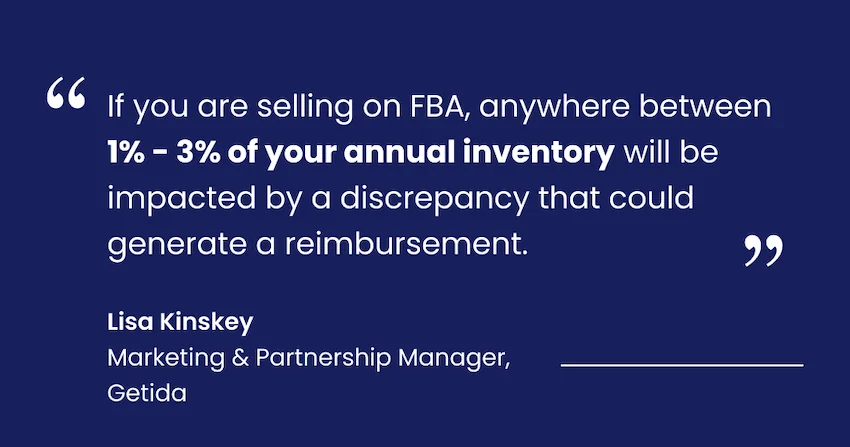
So whether this is your first product that you’re launching on the platform or you are an enterprise seller, just because of the volume that’s moving through FBA, they have lots of checks and balances and great processes in place, but things are going to slip through the cracks and things are going to go wrong by nature.
So anywhere between 1% – 3% of your inventory is impacted, and that again is the same for the size of the seller and also the location of the seller. We find this percentage to be true for stores in the US, stores in the UK and EU, you know, even further overseas.
So anyone in FBA, I would like to say, but it’s just a matter of how much money is left on the table for you within the last 18 months and moving forward.
The discrepancies for an FBA seller are going to be where the data the seller has on their inventory and the data that FBA has on their inventory differ.
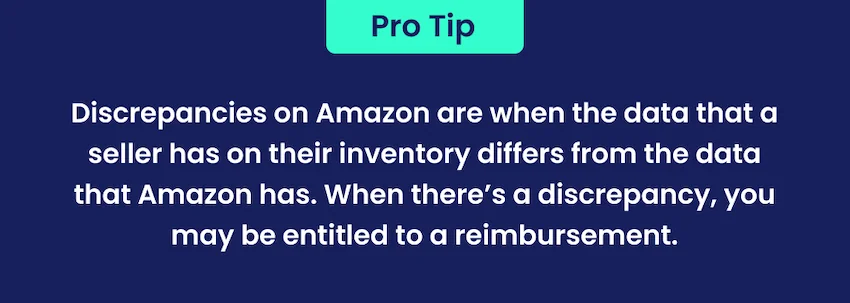
So in the example of checking your inbound shipments through your Seller Central account. If you shipped in an order of 100 units and they’re still receiving and they show maybe zero or 50 units, that’s okay because they’re still working on processing that order. But if you’ve shipped in an order of 100 units and they close it out, and say: “Received, closed out, we’ve got everything good to go,” and the units received is 90, there is a discrepancy between the data that Amazon has and FBA and the data that the seller has of what they have shipped.
So that is the most basic description of what a discrepancy is. Again, there’s many different discrepancy types that exist. This is kind of just the easiest to illustrate.
So sellers tend to miss out on the reimbursements and refunds from Amazon in their FBA inventory because of lack of information. They either are unaware that they’re eligible for this reimbursement or they get the email from Amazon once every couple of months saying, “Hey, we found a discrepancy. We’ve reimbursed you,” and they think that that’s all that is available. And that is just unfortunately not the case.
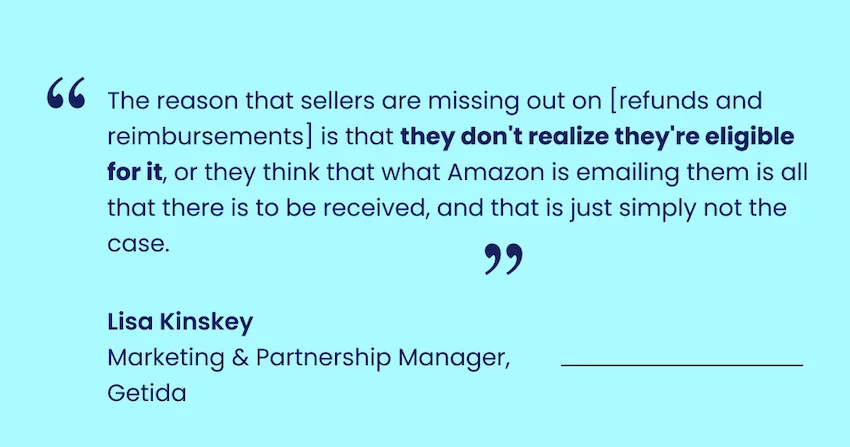
Amazon will reach out to you on anything that they find on their own, but as an organization it does not behoove them to investigate every single potential discrepancy, because think about the number of seller accounts that exist on Amazon. They would spend as much time looking into these discrepancies if they were self-initiated as they do processing the orders themselves.
So the reason that sellers are missing out on this is that they don’t realize they’re eligible for it or they think that what Amazon is emailing them is all that there is to be received, and that is just simply not the case.
That’s going to differ depending on the claim type. But in certain situations, Amazon will reach out to you for either a POP, a proof of purchase, or a POD, proof of delivery. So there’s going to be certain documentation that Amazon needs to finish and file these claims and issue the reimbursement. But these are services that Getida and our team of claim specialists will be able to assist you all with.
I think the common misconception about FBA reimbursements is that Amazon is already sending the seller all that is eligible for them, all that they are eligible for, and that is just not the case. I think that would be the greatest misconception.
My advice to sellers that are considering issuing claims for their reimbursements is to absolutely move forward with it as soon as possible.
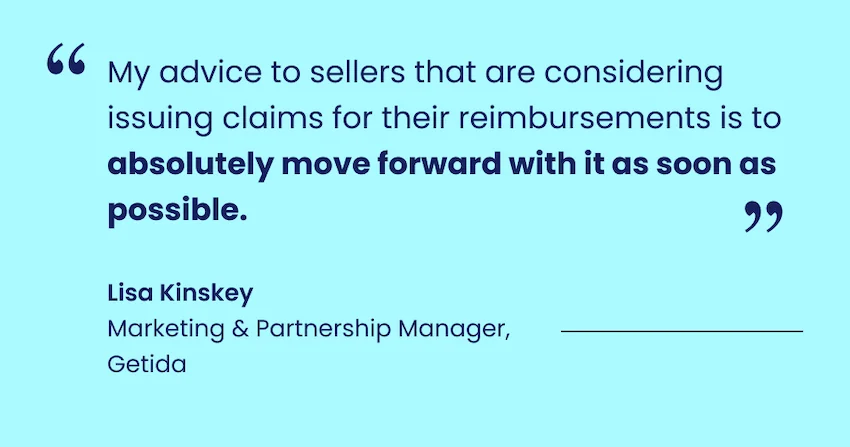
It doesn’t matter whether you’re launching your first product, if your store has been active six months or four years, you’re eligible for reimbursements for up to 18 months back in your business, and that’s going to make you more profitable overall. That’s going to give you more funds to reinvest back into your business. And if you’re looking to sell your business, that’s going to help you significantly to increase your multiple.
So doing your reimbursements won’t necessarily get you from a 5x to a 6x, but that five x will make a big difference if you’re a $1 million business versus a $2 million business. So start today. That would be my advice.
Getida is the global leader in FBA auditing and reimbursements through our dashboard, our proprietary award winning dashboard where sellers can log in and monitor their accounts.
Our claims team of over 80 folks who actually used to work in Amazon in these departments, we have successfully achieved the highest recovery success rate in the industry of over 80%.
So that’s kind of one of the differentiators of our service, I think. Getida’s also a pay-per-recovery service, so we only get paid when the seller gets paid. There’s no sign-on fee, no membership fee, no account connection fee or anything like that. We take a percentage when the seller is successfully reimbursed by Amazon, but if there’s a month where we’re still working on claims and nothing’s been reimbursed, or maybe everything looks good in FBA, our sellers will not receive a bill from us.
Subscribe to the eCommerce newsletter for
top industry insights

Stuck with extra inventory after Amazon’s Spring Sale? Learn five smart strategies to clear unsold stock, boost cash flow, and avoid future overstocks with smarter inventory planning.
![BFCM: The ultimate guide to eCommerce sales [2025]](https://www.8fig.co/wp-content/uploads/2023/09/cover-2-768x432.jpg.webp)
Get ready for Black Friday and Cyber Monday with our guide on maximizing sales through smart inventory management, effective marketing strategies, and leveraging eCommerce financing.

The holiday rush brings with it many challenges for eCommerce sellers. Get ahead of the competition with these top tips.
